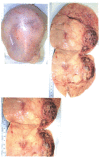Two case reports of a malignant germ cell tumor of ovary and a granulosa cell tumor: interest of tumoral immunochemistry in the identification and management
- PMID: 24982844
- PMCID: PMC4055855
- DOI: 10.3389/fonc.2014.00097
Two case reports of a malignant germ cell tumor of ovary and a granulosa cell tumor: interest of tumoral immunochemistry in the identification and management
Abstract
Objective: In this article, we present two case reports. The first case was a malignant germ cell tumor of the right ovary in a 23-year old woman and the second case was a bilateral undifferentiated granulosa cell tumor in a 71-year old woman. The aim of these reports is to illustrate the interest of the immunohistochemical analysis to define the correct diagnosis, to better classify these ovarian tumors and improve their management.
Methods: In this study, we report two cases. The first case concerns a 23-year old woman (A) with a mixed germ cell tumor of the right ovary [dysgerminoma (75%), yolk sac tumor (20%), and a mature teratoma (5%)], and the second case concerns a 71-year old woman (B) with a bilateral non-differentiated and necrotic granulosa cell tumor of both ovaries. The staging system was used according to both the classifications: International Federation of Gynaecology and Obstetrics 1987 for ovarian cancer and TNM code 2009.
Results: The immunostaining establishes the malignancy and the immunochemistry contributes to confirm effectively the right diagnosis (Tables 2 and 3).
Conclusion: An immunohistochemical analysis is mandatory for the choice of chemotherapy to obtain a better response of the disease and improve the survival prognosis. The efficiency of the chemotherapy authorizes a conservative surgery including a unilateral salpingo-oophorectomy preserving fertility (A). Concerning the non-dysgerminoma tumor (B), and after a surgical staging and debulking, chemotherapy was recommended. The type of tumor and its histological feature conditioned the choice of treatment. The benefit of the immunohistological analysis in this case allowed the right adjuvant treatment.
Keywords: dysgerminoma; germ cell tumors; immunohistochemistry; ovarian cell tumor; teratoma; yolk sac.
Figures
References
-
- Barber HRK. Managing ovarian tumors of childhood and adolescence. 3rd ed Ovarian Carcinoma-Aetiology, Diagnosis and Treatment. New York, NY: Springer-Verlag; (1993).
-
- Bailey J, Church D. Management of germ cell tumors of the ovary. Rev Gynaecol Pract (2005) 5:201–610.1016/j.rigp.2005.09.001 - DOI
LinkOut - more resources
Full Text Sources
Other Literature Sources
Molecular Biology Databases



